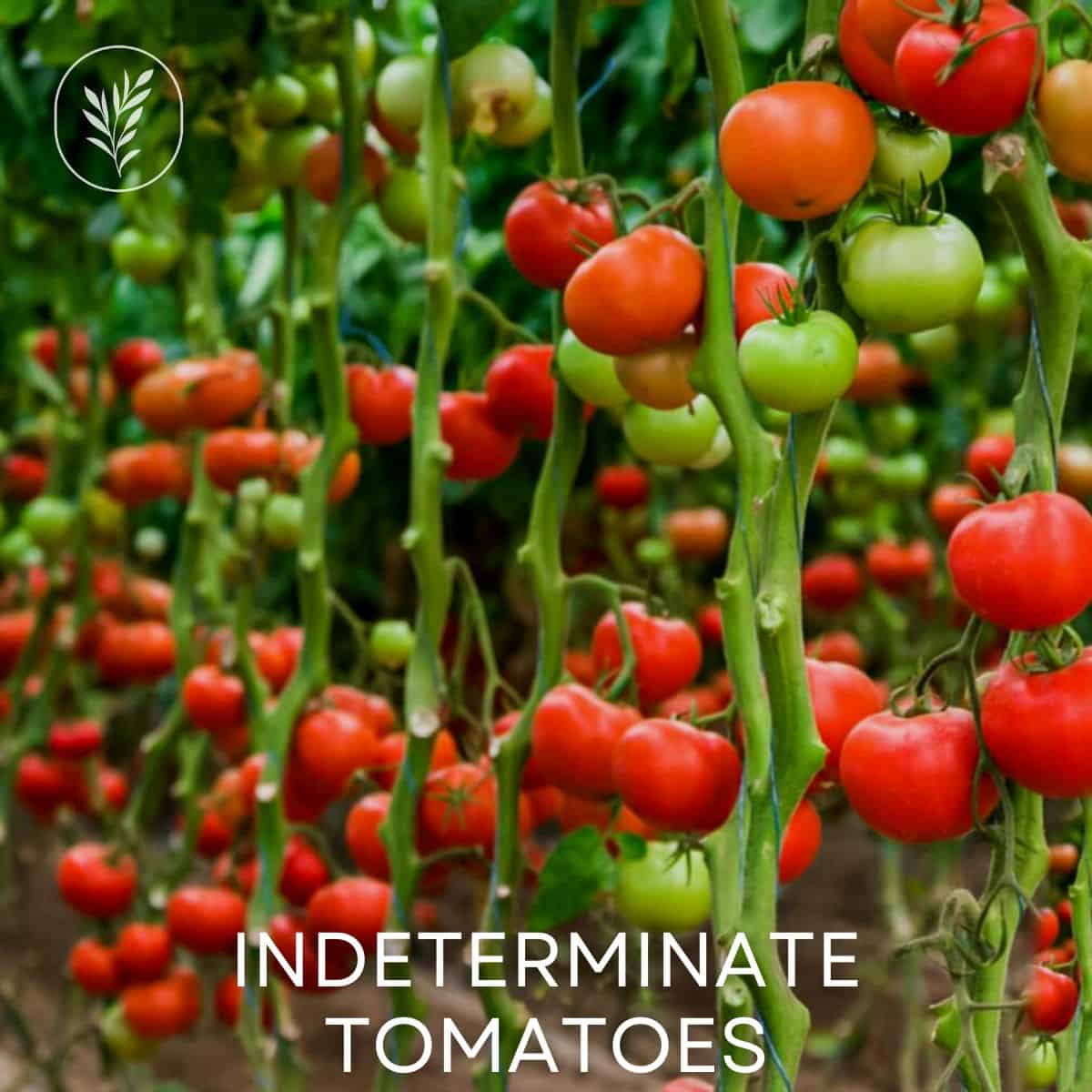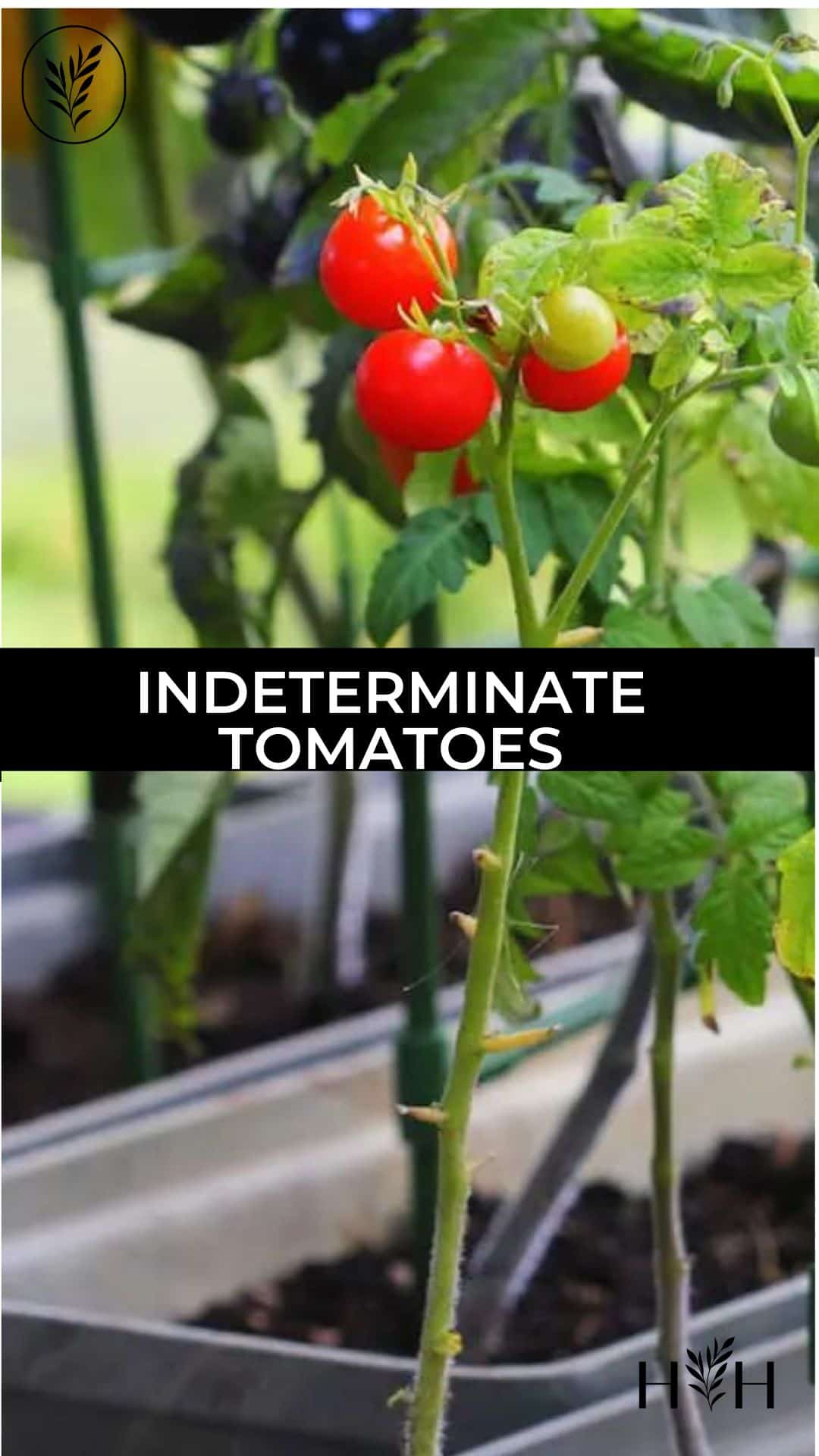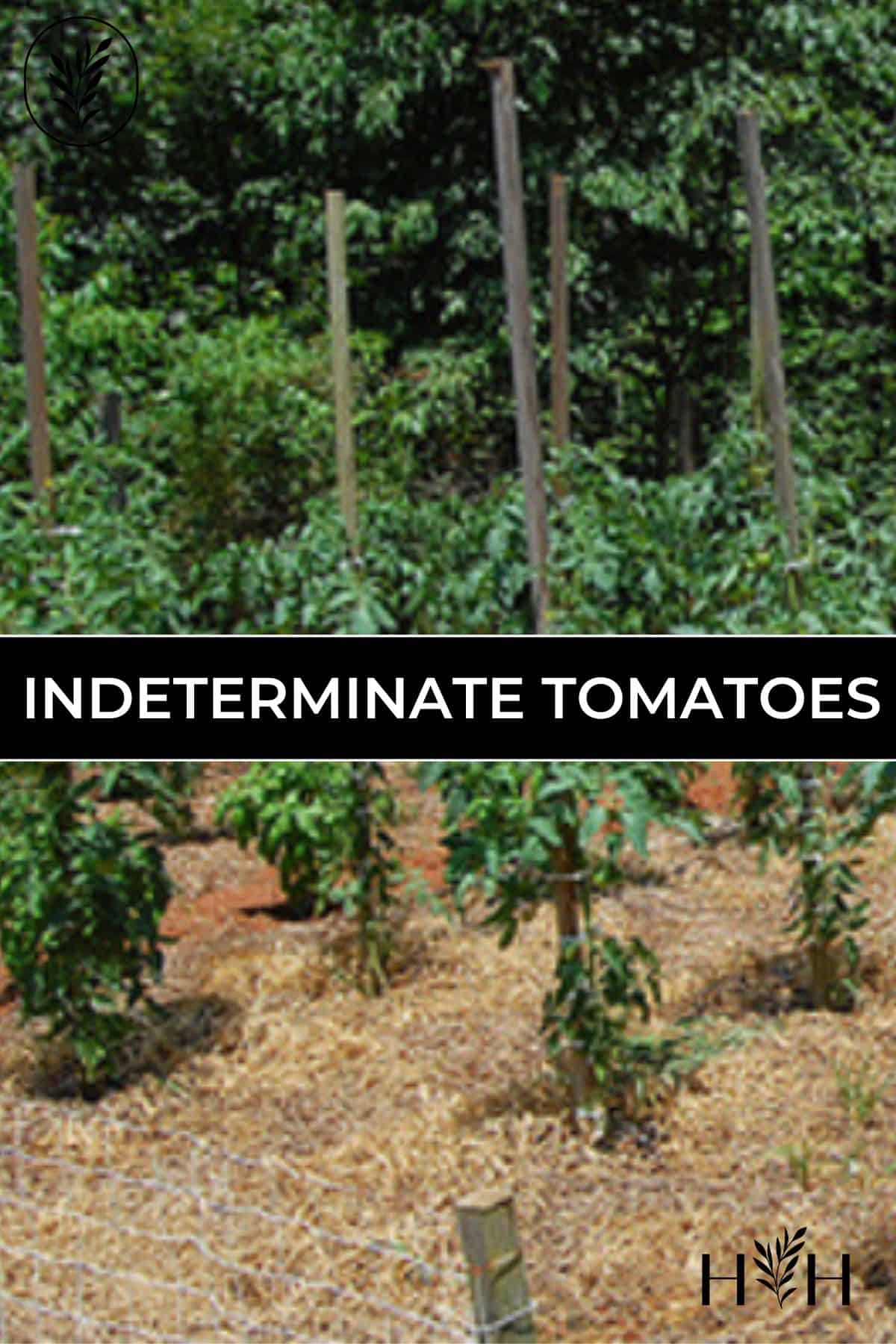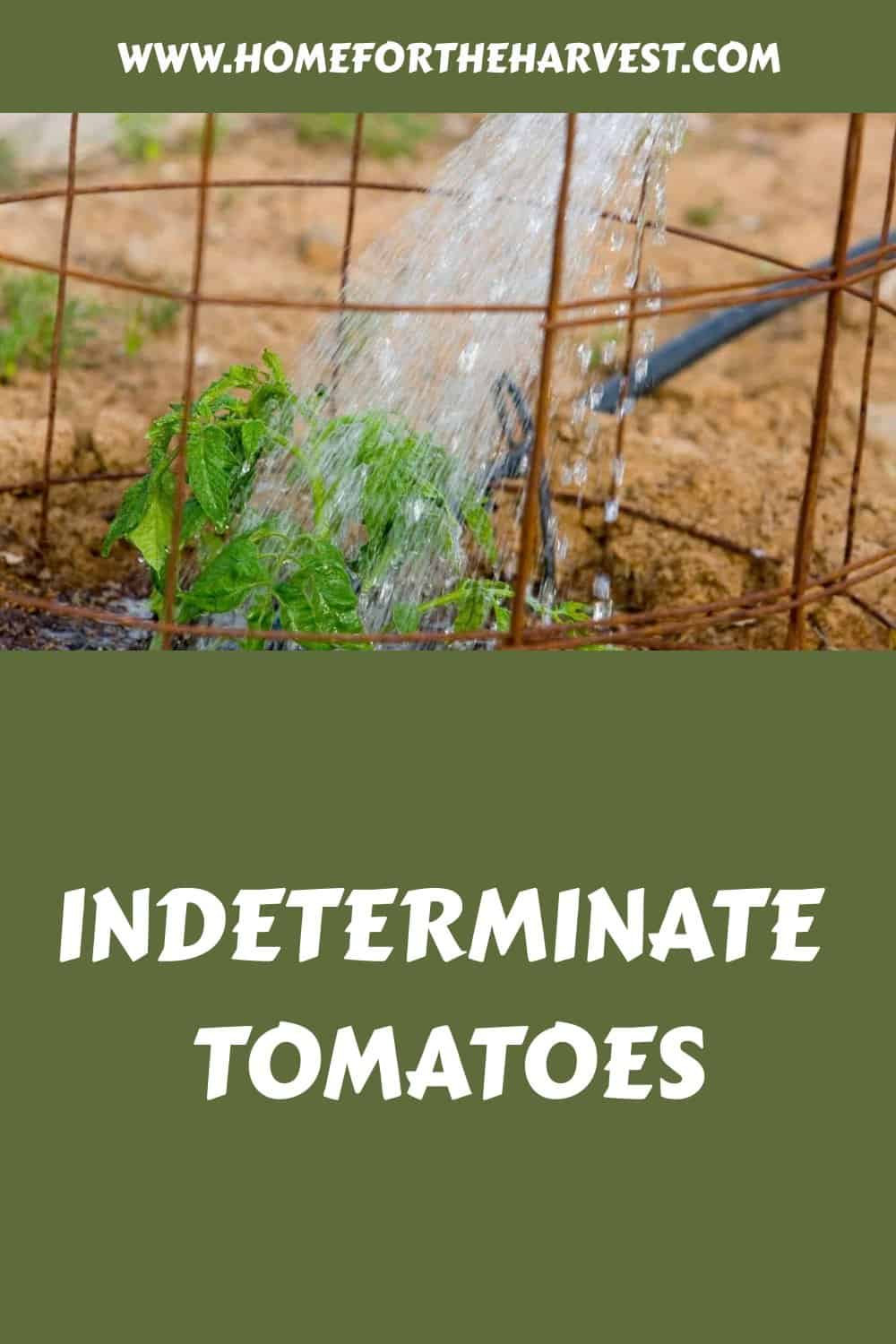Wondering about indeterminate tomatoes? Here are the basics of indeterminate tomato plants, including how to grow them, and how they differ from determinate plants, as well as a list of indeterminate tomato varieties (sorted by type).
Indeterminate tomatoes are varieties that grow long, branching vines and tend to grow flavorful fruits in small clusters over an extended time span. The vines are often 8-10 feet long and must be staked or supported with heavy-duty tomato cages as they continue growing until the plants are killed by frost or disease. Indeterminate tomatoes are perfect for an extended harvest and for the exceptional tomato taste offered by many indeterminate varieties.
Read on to learn all about indeterminate tomatoes!
“Indeterminates produce flowers and fruit sequentially throughout the season, making them great choices for folks who simply want to enjoy a nice steady supply of fresh tomatoes all summer long. Just be aware that indeterminate plants tend to be large and sprawling – the opposite of compact.”
You Bet Your Garden Guide to Growing Great Tomatoes: How to Grow Great-Tasting Tomatoes in Any Backyard, Garden, or Container, by Mike McGrath
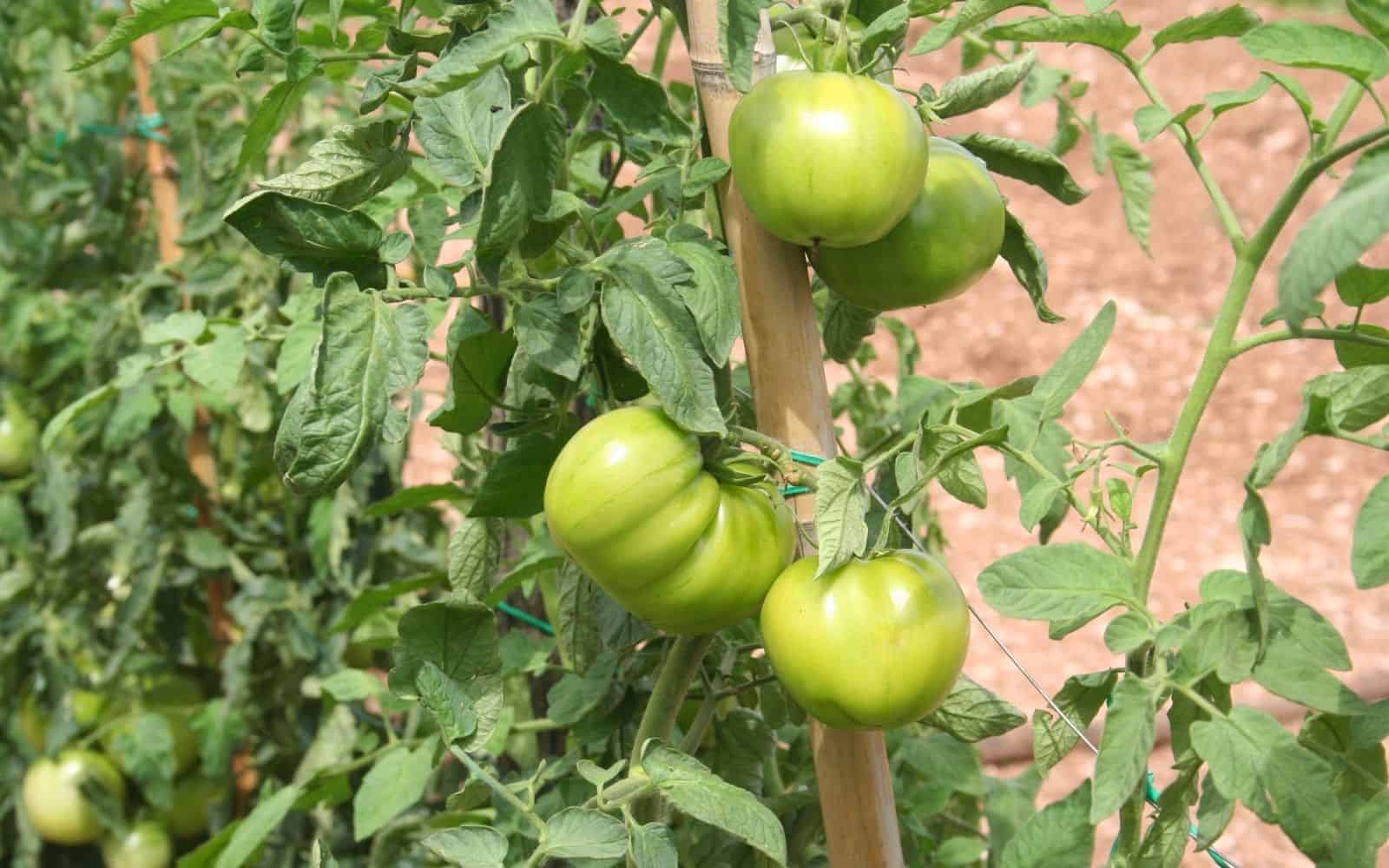
Indeterminate tomatoes: The basics
Indeterminate tomatoes are branching tomato plants that grow very long vines and produce indefinitely – until the plant is killed by frost or disease. These tomato plants are known for their vigorous sprawling vines and flavorful fruits. Most tomato varieties are indeterminate, as the determinate form of select varieties results from a genetic difference.
Indeterminate tomato plants produce flowers off the main central stem, and also off-side shoots. When flowers grow at the end of a branch, a sucker at the base of the branch extends itself and will take over production as the tomatoes on the first branch ripen. This leads to the continual production of new tomatoes until the plant dies. The extended harvest is perfect for backyard tomato enthusiasts who tend to their plants regularly.
“Indeterminate: This class of tomatoes is by far the most common, and its members grow upward and outward continually until killed by frost or disease. Indeterminate tomatoes have a central main stem from which side shoots, or suckers, grow at a 45-degree angle outward from the attachment point of the leaf stems.”
Epic Tomatoes: How to Select and Grow the Best Varieties of All Time, by Craig LeHoullier
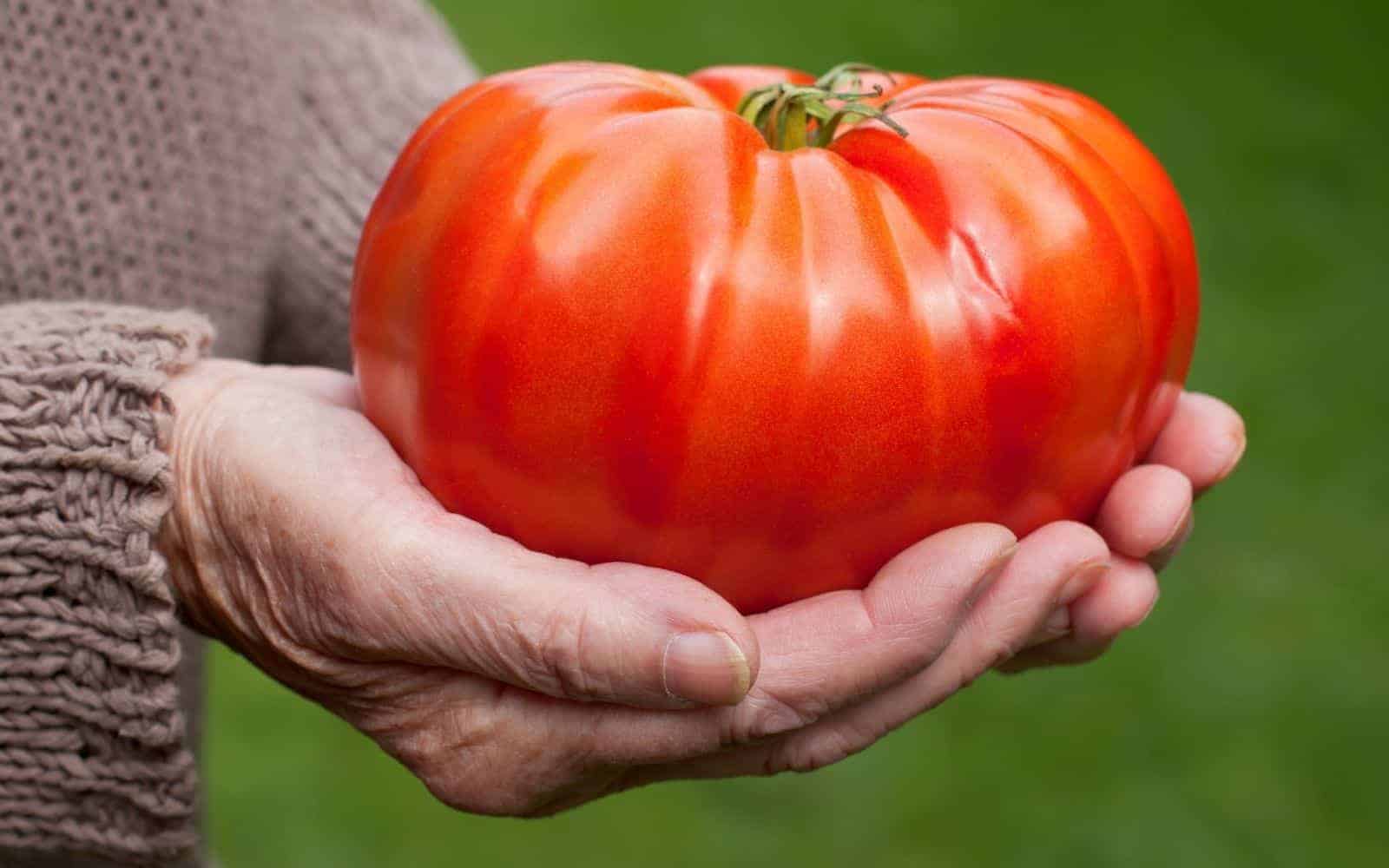
When to choose Indeterminate tomato varieties?
The most common reason for choosing to grow indeterminate tomato varieties is because of their exceptional flavor. Most of the best-tasting tomatoes grow on indeterminate plants. These large plants have lots of leaves to soak up sunlight and help the plant produce the complex flavor their tomatoes are known for.
Indeterminate tomatoes are also chosen by those wishing to grow prize-winning tomatoes. The tallest tomato plant ever grown (at a height of 65 feet (19.8 m)) was an indeterminate plant of the SunGold variety. The heaviest tomato ever grown (at a weight of 10 lb 12.7 oz (4.896 kg)) was an indeterminate plant of the Domingo variety.
“Another important characteristic of indeterminate varieties is the relatively high ratio of foliage to fruit, and all of that added photosynthesis means a significantly higher flavor potential when compared with determinate varieties.”
Epic Tomatoes: How to Select and Grow the Best Varieties of All Time, by Craig LeHoullier
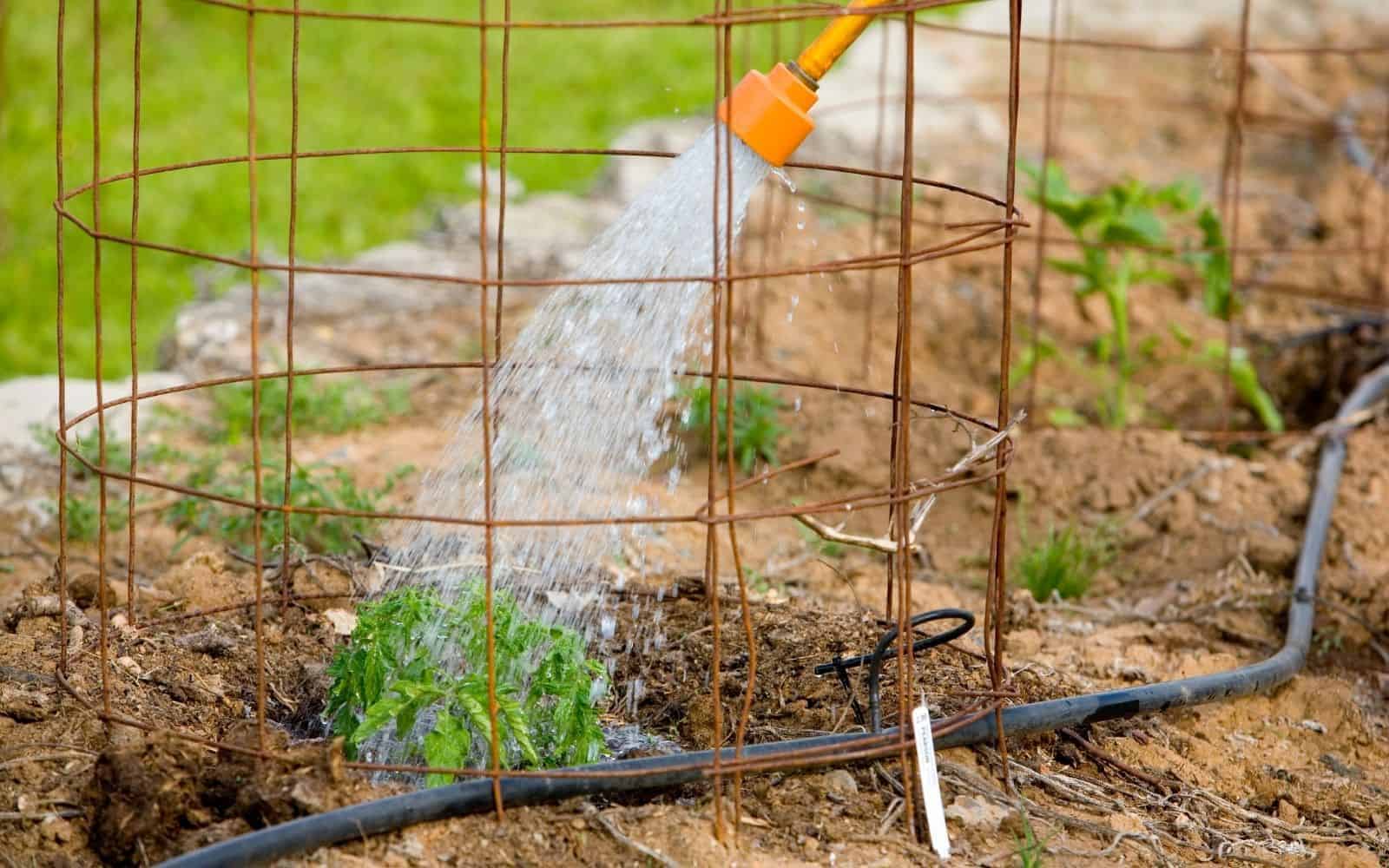
Indeterminate tomatoes vs. Determinate tomatoes
Indeterminate tomato plants produce long, rambling vines which branch freely to produce huge plants. Determinate tomato plants naturally form a compact bush-like shape.
Indeterminate varieties can easily reach 10 feet tall (or greater if well-supported). Determinate tomato plants tend to reach a maximum height of 3-4 feet tall.
Indeterminate seedlings look the same as determinate seedlings until they reach about a foot tall. As they grow taller, indeterminate seedlings become visibly leggier than bushy, compact determinate varieties. Indeterminate seedlings are generally staked as they reach 1 foot tall, while determinate seedlings are rarely staked.
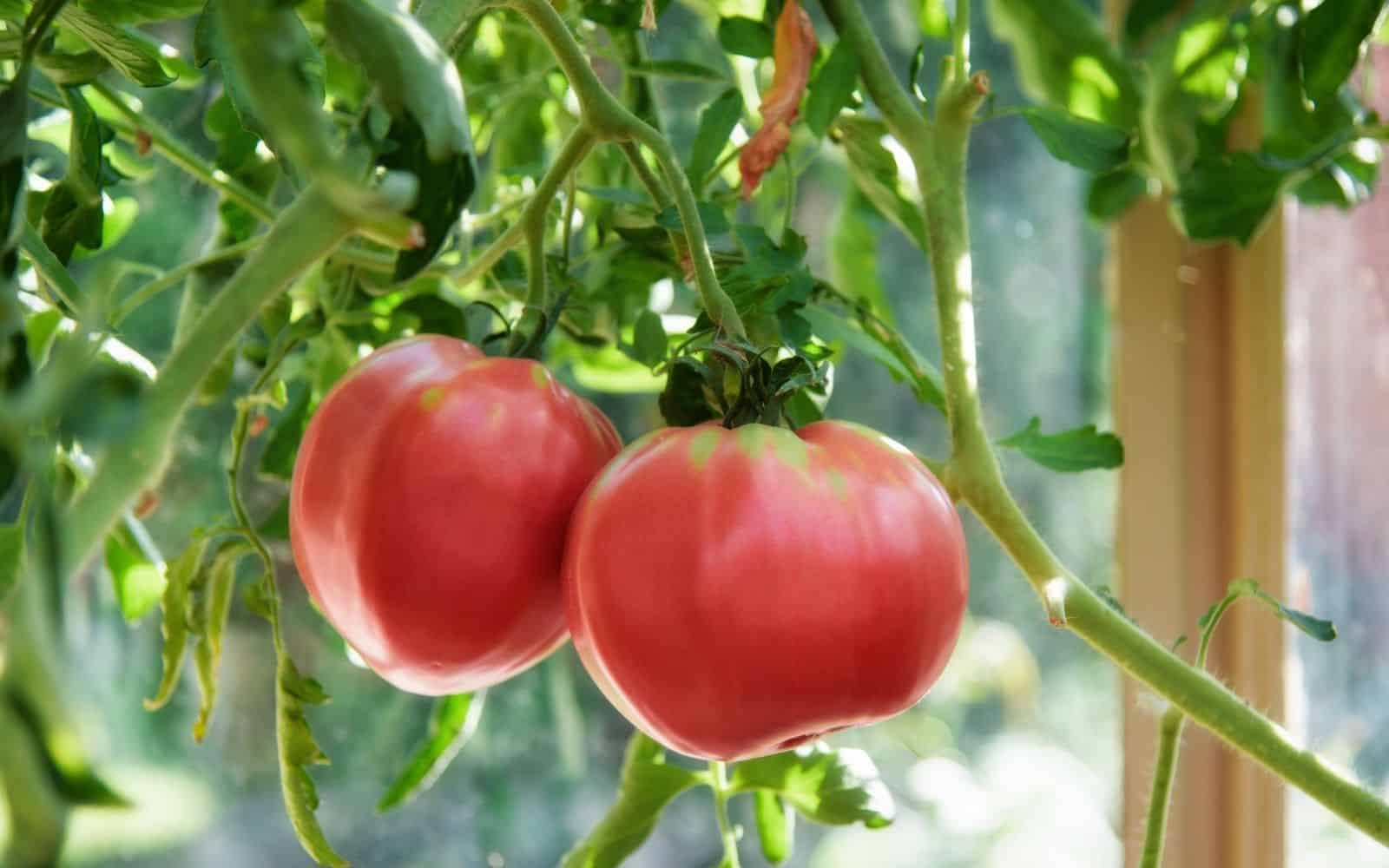
Indeterminate tomatoes must be staked (sometimes with multiple stakes) and/or caged inside a large heavy-duty tomato cage (typically made of metal animal fencing or concrete reinforcing mesh). Determinate tomatoes often require only a minimal tomato cage (such as the conical ones at the hardware store).
Indeterminate varieties grow their fruit slowly but surely for an extended harvest over a long span of time. Determinate tomato plants produce the majority of their fruits all in one big batch.
Indeterminate tomato varieties tend to have more foliage on the plants for the amount of fruit grown. Determinate tomato plants tend to have a greater ratio of fruit to foliage, making them more productive than indeterminate plants in the short term.
“Most of the old, great-tasting heirloom varieties – and big tomatoes in general – are indeterminate. The yield on some indeterminate plants is sometimes smaller than that of the more compact varieties, but sometimes their extended tomato production time evens things out over the course of a season.”
You Bet Your Garden Guide to Growing Great Tomatoes: How to Grow Great-Tasting Tomatoes in Any Backyard, Garden, or Container, by Mike McGrath
Indeterminate tomatoes may need to be pruned to control the size and shape of the plant, or to increase air circulation to combat foliar disease. Determinate tomato varieties typically don’t require pruning.
Indeterminate tomato plants grow longer indefinitely and produce fruit indefinitely until the plant is killed by frost or disease (or pruning shears and a shovel). Determinate tomatoes complete the bulk of their life cycle in about 4-6 months.
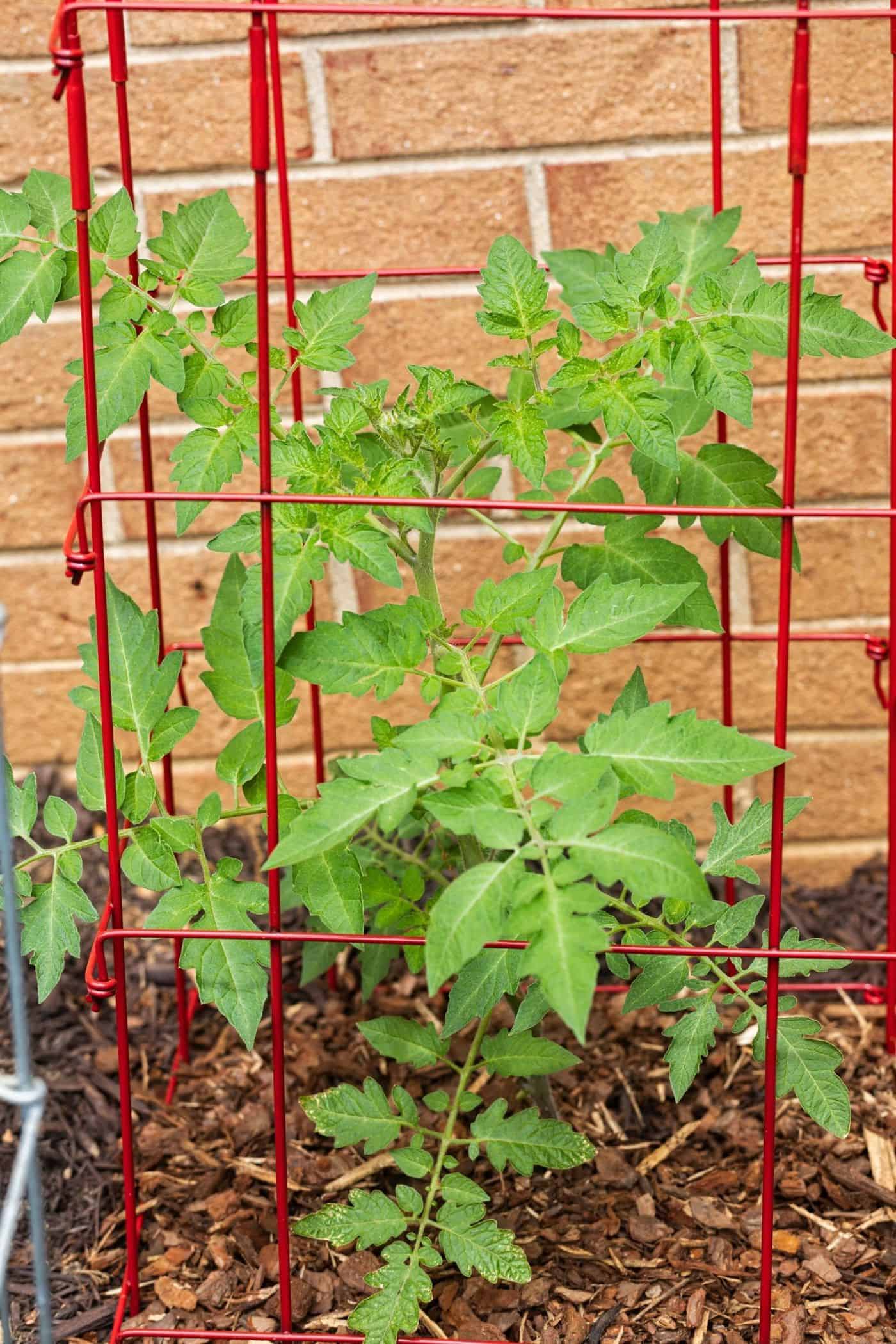
How to grow Indeterminate tomatoes?
Indeterminate tomato varieties can be a bit more difficult to grow than their determinate counterparts, as they require more attention in terms of supporting the plants. They also grow for a longer time period.
Plant indeterminate tomato plants outside when daytime low temps are no lower than 43°F (6°C). Tomato plants grow best in full-sun locations. Keep the plant watered consistently throughout the growing season.
Provide support for the tomato plant as soon as possible after planting. Support for indeterminate tomato plants usually consists of a vertical tomato stake to support the central stem, plus a surrounding heavy-duty tomato cage to contain and support branching vines.
Place a tall vertical tomato stake at the base of the plant. Gently tie the main central stem to the stake with a loop, leaving room to allow the tomato to grow. For the greatest amount of support, place a heavy-duty tomato cage around the plant.
Indeterminate plants grow best (and require less maintenance) when they have large tomato cages to contain and support their giant vines. While some heavy-duty cages are available pre-made, many gardeners opt to make their own from animal fencing. Indeterminate tomato plants grown without cages will require frequent tying maintenance against their stake and usually require pruning to control the size of the plant.
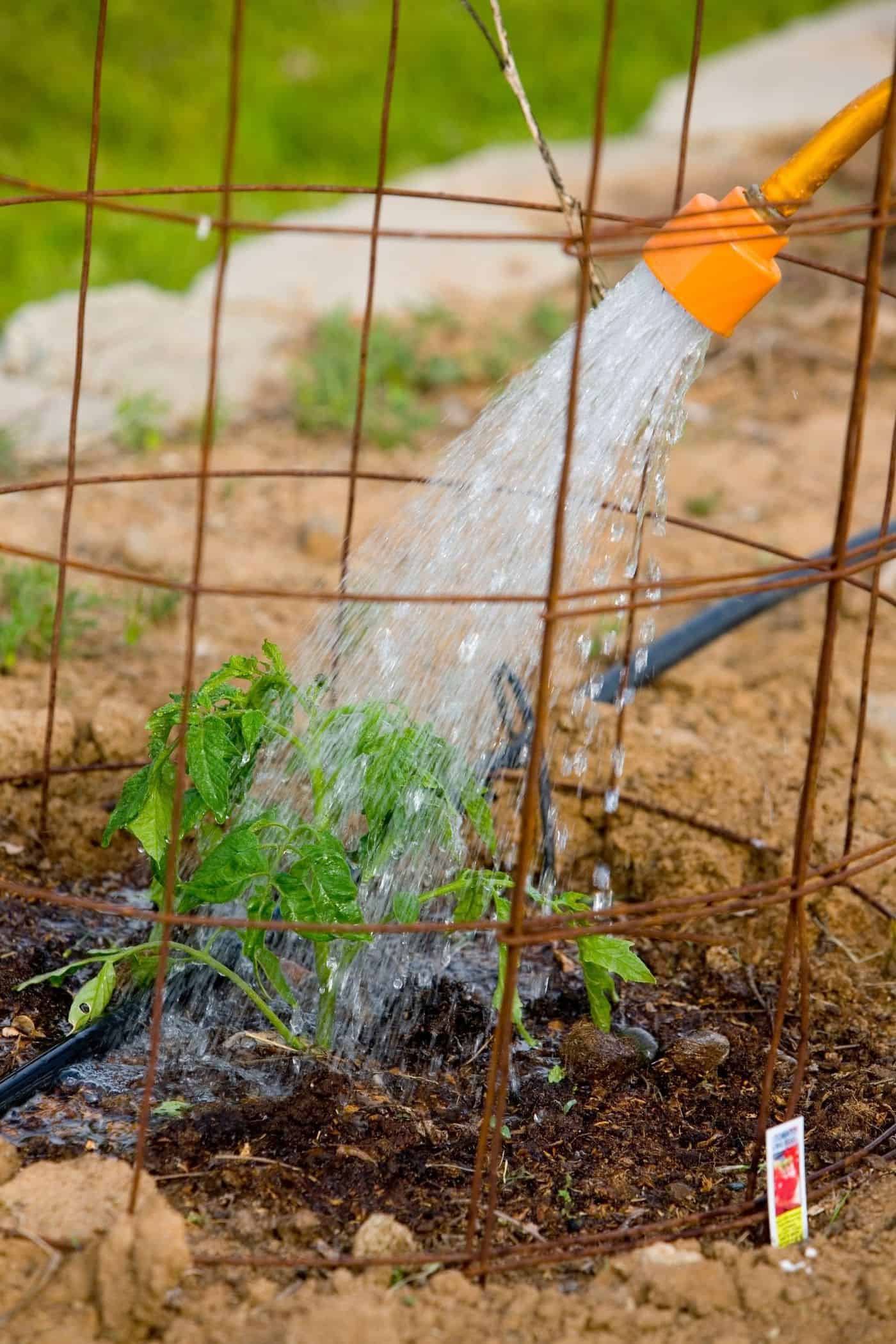
Indeterminate tomato plants can be grown in containers, as long as the containers are large enough to support these big plants. if growing in a container, try for a volume of at least 10 gallons, if possible. Use a nursery pot from a large tree or a 10-20 gallon grow bag.
“Tomatoes are characterized as either determinate or indeterminate. In both cases, the creation of a flower terminates the growth of a particular shoot. In the case of the indeterminate type, when a flower terminates the shoot’s growth, the plant has the capacity to develop branches that can continue indefinitely; therefore indeterminate varieties tend to grow into taller, leggier-type plants As a result, they require more attention in supporting and managing.”
The Complete Guide to Growing Tomatoes: Everything You Need to Know Explained Simply — Including Heirloom Tomatoes, by Cherie Everhart
Indeterminate standard globe-shaped tomatoes
Here are some common indeterminate globe-shaped round tomatoes (also called salad tomatoes or medium-sized slicers)
- Early Girl Tomato
- Carbon Tomato
- Green Zebra Tomato
- Arkansas Traveler Tomato
- Bonny Best Tomato
- Oh Happy Day Tomato
- Quarter Century Tomato
- Razzle Dazzle Tomato
- Red October Tomato
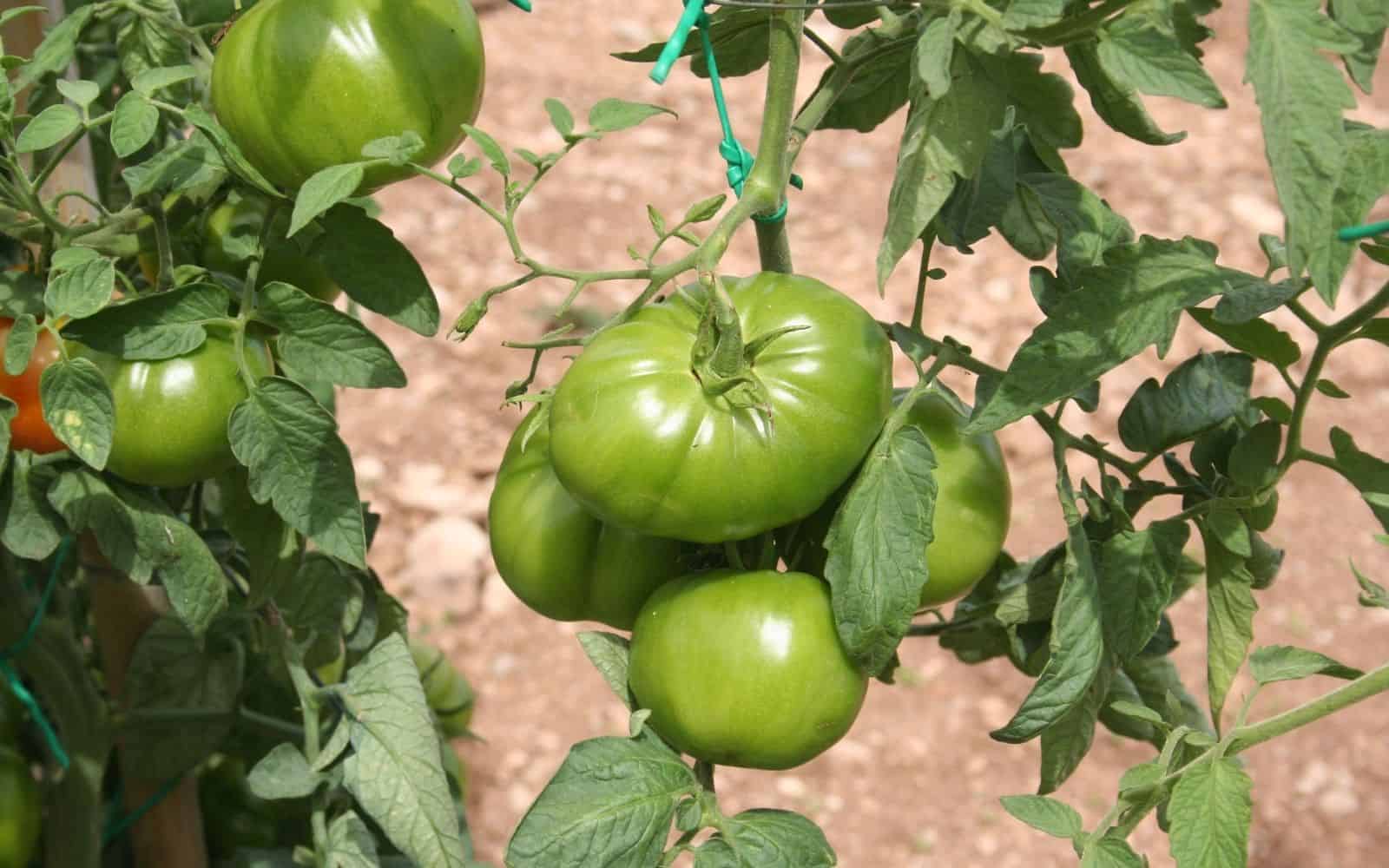
Indeterminate Beefsteak tomatoes
Here are just a few of the many indeterminate beefsteak tomato varieties (large slicers):
- Mortgage Lifter Tomato
- Brandywine Tomato
- Cherokee Purple Tomato
- Black Krim Tomato
- Kellogg’s Breakfast Tomato
- Burpee’s Big Boy Tomato
- Better Boy Tomato
- Pineapple Tomato
- Brandy Boy Tomato
- Big Beef Tomato
- Aunt Ruby’s German Green Tomato
- German Queen Tomato
Indeterminate Plum tomatoes
Here are some indeterminate plum tomatoes (paste tomatoes):
- San Marzano Tomato
- Juliet Tomato
- Amish Paste Tomato
- Big Mama Tomato
- Orange Banana Tomato
- Opalka Tomato
Indeterminate Cherry tomatoes
Here are some popular indeterminate cherry tomato varieties:
- Sungold Tomato
- Sun Sugar Tomato
- Black Cherry Tomato
- Sweet Million
- Sweet 100
- Super Sweet 100
- Gardener’s Delight Cherry Tomato
- Napa Grape Cherry Tomato
- Whippersnapper
Indeterminate oxheart tomatoes
Here are some indeterminate oxheart tomatoes:
- Anna Russian Tomato
- Red Oxheart Tomato
- Cour di Bue Tomato
- Hungarian Heart Tomato
- Kosovo Tomato
- Linnie’s Oxheart
- Livingston’s Giant Oxheart Tomato


